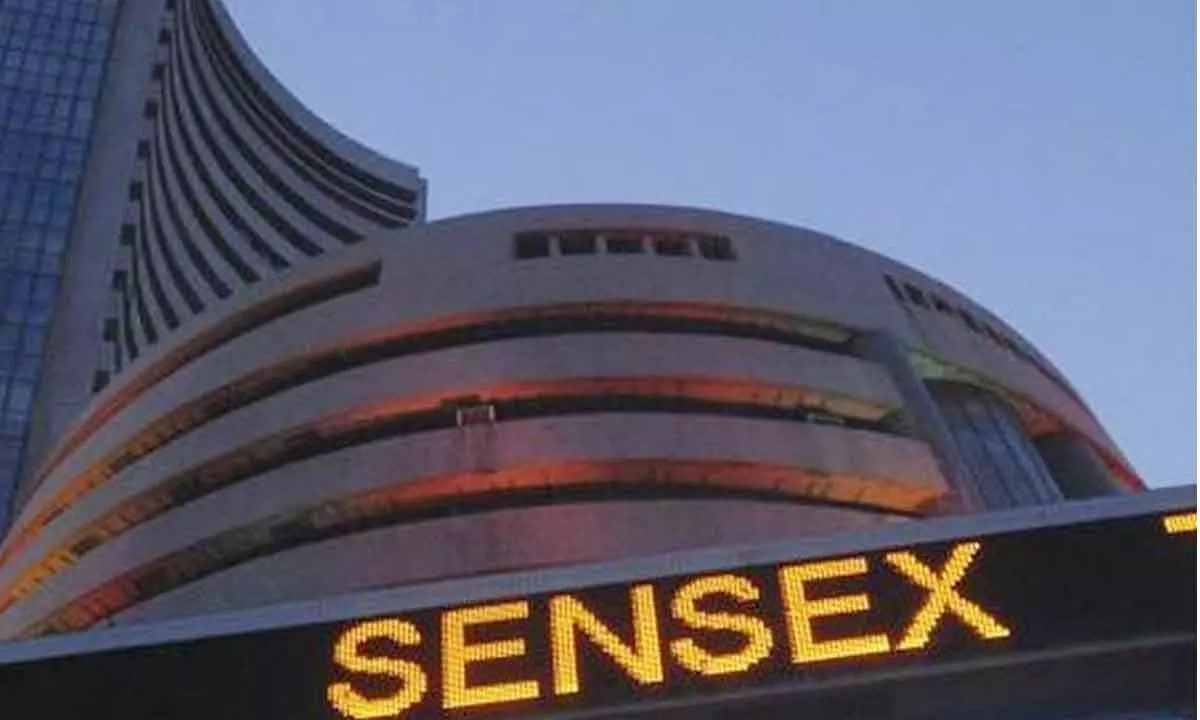Mid, small cap stocks to outperform frontline scrips

BSE Sensex
Key factors that will guide markets in near term are: F&O settlement, Q2 earnings, international crude oil prices, rupee-dollar movement, developments in Euro zone like resolution to UK political crises and Russia-Ukraine conflict
Ahead of the Diwali festival, buoyed by positive global cues, better than expected Q2 earnings and renewed buying from FIIs; the domestic stock market stayed bullish with positive sentiment during the week end. For the week, BSE Sensex added 1,387.18 points or 2.39 percent to end at 59,307.15, while NSE Nifty gained 390.6 points or 2.27 percent to close at 17576.3. However, the broader market displayed extreme caution with the Mid-cap and Small-cap indices closing on a flat note. During the week, FIIs bought equities worth Rs1,324.34 crore, while DIIs bought shares worth Rs3,569.49 crore. In October till date, FIIs have, so far, sold equities worth Rs 8,653.92 crore, while DIIs bought equities worth Rs11,624.54 crore. The rupee breached the 83-mark for the first time, sinking to 83.29 in the week gone by, falling more than four percent in a month due to a stronger dollar and a widening current account deficit. Many lesser known companies outperformed the larger peers and the so-called bluechip counters in the Samvat 2078. Market observers expect the trend to continue and midcap and small-cap stocks will continue to shine brighter than the frontline companies in the upcoming year, that is, Samvat 2079. Though FIIs have been aggressive sellers in Samvat 2078, retail investors have been relentlessly investing through the SIP route over the last two years. The net inflows through SIPs hit an all-time high of Rs12,976 crore in September. In the six months ended September, the total inflows through SIPs stood at Rs74,230 crore, which is higher than Rs56,451 crore seen in the same period last year. Expect Samvat 2079 to be another happy investing year for the retail community say savvy old timers.
Key factors that will guide markets in near term are F&O settlement, Q2 earnings, international crude oil prices, rupee-dollar movement, developments in Euro zone like resolution to UK political crises and Russia-Ukraine conflict. In the week ahead, markets have a three-day short trading week. Monday will have just a symbolic Muhurat trading session and usually no major decisive moves are seen; and Wednesday is a trading holiday again. However, when the markets open on Thursday once again after a holiday on Wednesday, it will find itself adjusting to the global trade setup.
Listening Post: Investors' expectations of their long-run portfolio gains are far-fetched. In one recent survey, wealthy individuals said they expect their portfolios to earn a long-run average of 15 per cent annually after inflation. With bonds yielding roughly five per cent, a typical stock-and-bond portfolio would need stocks to grow at 20 per cent annually to hit that overall 15 per cent target. Individuals aren't the only investors who believe in the improbable. One in six institutional investors, in a survey, projected gains of more than 30 per cent annually on their investments even when many funds, on average, have underperformed the stock market for much of the 2000s. Although almost nothing is impossible in the financial markets, these expectations are so far-fetched they border on fantasy. The traditional explanations for believing in an investing tooth fairy who will leave money under your pillow are optimism and overconfidence: Hope springs eternal, and each of us thinks we're better than the other investors out there. There is another reason so many investors believe in magic: We can't handle the truth. The efficient-market hypothesis holds that stock prices fully reflect all the relevant information that is available. What if, instead, investors are so efficient at avoiding some information that it might as well not even exist? This behaviour is called 'information avoidance.'
You could also call it intentional ignorance. Many investors avoid information if it's going to make them feel or behave or think in a way they don't want to—especially any evidence that could jeopardize their belief in their competence and autonomy or could require taking difficult or prolonged action. After all, information isn't just bits of data or trivia. It can also be the cause of pleasure or pain. If the information is pleasant, that positive feeling gives you more incentive to pay attention to it. Painful information can push you to ignore it. Think of people declining to get tested for the genetic markers of a hereditary disease, or a smoker whose cigarette packs might as well have that surgeon-general warning printed in invisible ink. Investors often act much the same way. It is common that investors check the value of their financial assets much less frequently, on average, in down markets—it's a behaviour that researchers call 'the ostrich effect.' Decades of research have documented that people are much less willing to sell investments that have dropped in price. To 'realize' a loss means not only to make it actual, but also to become aware of it. If you don't lock in a loss by selling it, you don't have to think about it or admit you made a mistake. Such behaviour isn't always bad. Covering your eyes and ears during a market downturn can keep you from kicking yourself with regret—and from bailing out near the bottom. However, you can't tell whether your ideas are valid unless you let them be challenged. Just as the most partisan voters—of all stripes—shouldn't remain deaf and blind to evidence that their favorite politicians might be wrong, Investors would spare themselves embarrassment and loss by confronting information instead of hiding from it. So, when you or your financial adviser estimates future performance, ask: What are the sources of this expected return (income, inflation, capital appreciation and so on)? How much of the total will come from each? How do those expectations compare to the long-term past results and, if they differ, by how much and why? While not impossible, anyone calling for even higher returns after years of robust gains in stock markets around the world needs to look for loopholes in his or her logic.
Finally ask: What conditions or circumstances would it take for me to be proven wrong? If your answer is none or that's impossible, you have a severe case of information avoidance. The only cure for that might be the shock of losses that come at you like a bolt from the blue.
Quote of the week: "Courage taught me no matter how bad a crisis gets ... any sound investment will eventually pay off." — Carlos Slim Helu
Don't despair amid the inevitable setbacks that all investors face, especially during a crisis in the market. If the reasoning behind the investment was sound, stick with it, and it should eventually turn around.
F&O / SECTOR WATCH
On the back of sharp swings in global markets, the derivatives segment witnessed heightened volatility. The past five sessions saw the index trading in a range of 572 points, which was wider than what was seen over the past few weeks. Nifty surged more than two per cent, while Bank Nifty ended the week with gains of more than 3.5 per cent. Maximum Call Open Interest (OI) was seen at 18,000 strike, followed by 18,200 &17,600 strikes and unwinding at 17,400 &17,300 strikes. Maximum Put OI was seen at 17,500 strike followed by 17,000 and 16,500 strikes; and unwinding at 16,000 & 16,500 strikes. Implied Volatility (IV) of Calls closed at 16.25 per cent, while that for Put options closed at 17.53 per cent. The Nifty VIX for the week closed at 17.23 per cent. PCR of OI for the week closed at 1.23. The options data indicated that the Nifty may trade in the range of 17,400-18,000 levels in the coming sessions. Banking is leading from the front and the Bank Nifty could hover in range of 40500-41000 zone. Undertone of the market is positive, but however the focus should remain on stock selection and risk management. Reliance Industries had announced along with the Q2 earnings, to demerge and list financial services business. Shareholders of RIL will receive one equity share of JFS of face value Rs10 for one fully paid-up equity share of Rs10 held in RIL. The investment of RIL in Reliance Industrial Investments and Holdings, which is a part of the financial services undertaking of RIL, will stand transferred to JFS. RIIHL is the ultimate beneficiary of 6.1 per cent RIL shares through its interest in Petroleum Trust and Reliance Services and Holdings. The turnover of the financial services business as of March 31, 2022, was Rs1,387 crore, which is 0.3 per cent of the total turnover of RIL. Buy on declines RIL for unexpected bonanza gains. Stock Futures looking good are ABFRL, Ambuja Cements, Mindtree, Metropolis, MRF, Titan Inds and RBL. Stock Futures looking weak are Berger Paints, Crompton, IEX, Sun TV, Tata Motors and Voltas.

















